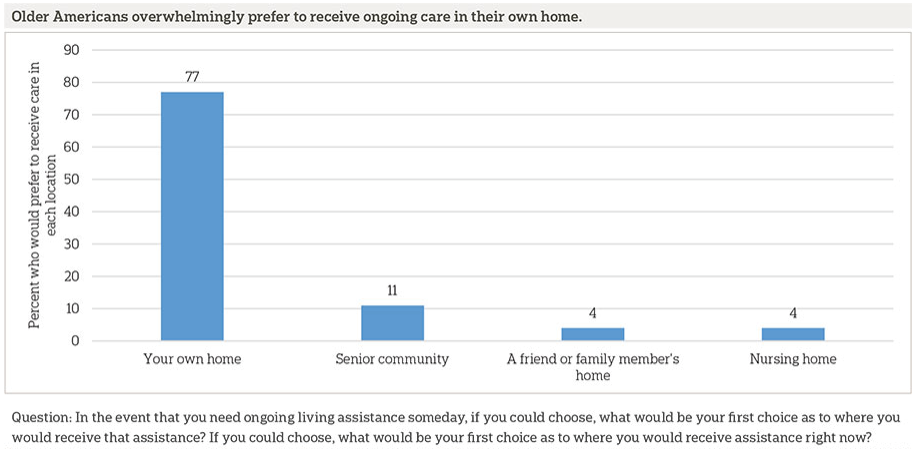Most Americans would prefer to receive senior care in a home setting. That does not mean that they see professional Certified Nursing Assistants as the ideal caregivers. In survey findings released by The Associated Press and independent research organization NORC at the University of Chicago asked participants where they would prefer to receive ongoing care should they need it, 77% of people said their own home. A senior community was the runner-up chosen by only 11% of respondents. Of the people preferring in-home care, 22% said a professional home health aide would be their first choice for caregiver and, 70% said they would prefer for a family member to provide care. Men are more likely than women to want a spouse to provide care and women are more likely to prefer children as caregivers. This desire to rely on close family for care may be understandable, but it does not reflect what is currently occurring, given that 46% of those people currently receiving home-based care receive services from an unrelated aide. Family members provide care in 52% of these cases. Relying on a spouse or family member for in-home care has downsides for the family caregiver. These stressors may entail financial and mental health implications and a change in the dynamics of the relationship. According to Home Health Care News the authors of a 2016 report state, “Those with experience caring for a spouse or partner were the least likely to say it was a positive life experience. They were also the most likely to say the experience caused stress in the family, was a burden on personal finances, and weakened their personal relationship with the person for whom they cared.” Despite the overwhelming majority desiring care in home, most individuals are unaware of the details of financing long term health care or paying for home health care. About one-third of respondents with a household income of $50,000 or more expect that Medicare will be a primary payer for in-home services by an aide as they age. This is not true. In fact, State based Medicaid programs are the nation’s largest payer for long-term care; but those funds are only available to those with very low incomes or once a senior has spent down his or her assets. 
Source: Long-Term Care in America: Expectations and Preferences for Care and Caregiving Given the overwhelming preference for aging in place while requiring assistance, older adults should plan accordingly in order to be able to stay where they feel the most comfortable. An option would be to invest in a long term care insurance policy or a life insurance policy that includes coverage for home care in order to be able to age in place or saving them money to cover this care directly. Other notable findings from the survey include: – 45% of respondents listed losing memory/mental abilities as their top concern regarding aging – 43% cited losing independence and having to rely on others as their top concern – 33% of respondents said they have no planning for their own long-term care needs References Mullaney, T. (2016, May 23). Aging-in-Place Wildly Popular, Home Health Aides Less So. Retrieved from: http://homehealthcarenews.com/2016/05/aging-in-place-wildly-popular-home-health-aides-less-so/ Tenenbaum, L. (2010, September). The MetLife Report on Aging in Place 2.0. Retrieved from: https://www.metlife.com/assets/cao/mmi/publications/studies/2010/mmi-aging-place-study.pdf

Source: Long-Term Care in America: Expectations and Preferences for Care and Caregiving Given the overwhelming preference for aging in place while requiring assistance, older adults should plan accordingly in order to be able to stay where they feel the most comfortable. An option would be to invest in a long term care insurance policy or a life insurance policy that includes coverage for home care in order to be able to age in place or saving them money to cover this care directly. Other notable findings from the survey include: – 45% of respondents listed losing memory/mental abilities as their top concern regarding aging – 43% cited losing independence and having to rely on others as their top concern – 33% of respondents said they have no planning for their own long-term care needs References Mullaney, T. (2016, May 23). Aging-in-Place Wildly Popular, Home Health Aides Less So. Retrieved from: http://homehealthcarenews.com/2016/05/aging-in-place-wildly-popular-home-health-aides-less-so/ Tenenbaum, L. (2010, September). The MetLife Report on Aging in Place 2.0. Retrieved from: https://www.metlife.com/assets/cao/mmi/publications/studies/2010/mmi-aging-place-study.pdf

